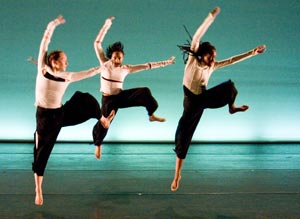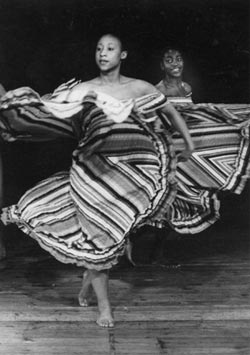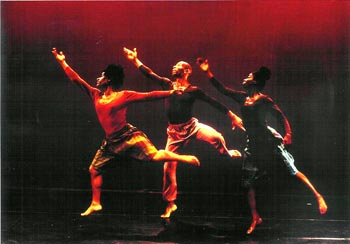BLACK
DANCE IN ENGLAND: THE PATHWAY HERE
by Hilary Carty
Hilary Carty was formerly Director of Dance
at the Arts Council of England. From the perspectives
of
both artist/choreographer in the 80s and policy-maker
from the mid 90s, she experienced at first hand the
highs and lows of black dance in England. We asked
her to capture those insights for future generations…
Looking across Europe, Britain is fortunate
in having one of the most diverse portfolios of
artists consistently funded. The diversity of dance
forms
spans from the traditional to the contemporary
with every nuance at the margins of both. Even
with the
decline in the number of companies witnessed in
the last couple of decades, the range is notable.
That
diversity is undoubtedly to be celebrated - it
also presents us with a challenge - that
of definition.
Today’s artists defy strict
categorisations and, as we look at the many hybrid
upon hybrid forms
created in the diverse cultural environment that
Britain has become, it is worth starting this discussion
by exploring the rather unwieldy and unspecific
term ‘black
dance’ itself.
Black Dance or African Dance?
‘Black’ is essentially a political term
used in the United States during the civil rights
movement to positively affirm the history and culture
of African
Americans. In the British context, however, the
phrase ‘black’ whilst
being used to identify African descendents, was
extended to identify and affirm a positive affiliation
with
people who have a history of colonisation and oppression
by the British - hence it being used to include
Asian communities and even the Irish in some instances.
With such a loose coalition of meanings, it becomes
difficult to comfortably use the word ‘black’ in
artistic terms - it is subjective and very much
open to interpretation.
 Within the arts sector,
there has been serious debate on titles for over
30 years - many conferences
and articles have tried to dissect every nuance without
comprehensive success. I will not spend a lot
of time on that here, but suffice to say that language
is a living entity which develops as communities
develop - there is little ‘right or wrong’ in
a living language; terms that appear apt within
one decade become tainted and discarded in
the next. Within the arts sector,
there has been serious debate on titles for over
30 years - many conferences
and articles have tried to dissect every nuance without
comprehensive success. I will not spend a lot
of time on that here, but suffice to say that language
is a living entity which develops as communities
develop - there is little ‘right or wrong’ in
a living language; terms that appear apt within
one decade become tainted and discarded in
the next.
This discussion of black dance will focus around
dance that has its root in the African cultural
idioms whether it be dance that is traditional,
classical,
contemporary, modern, modernist, new or hybrid
developments from that base culture. In the
UK, when we use the
term ‘African’ dance, there is often
a connotation that we are talking about traditional
dance - such as that performed by Adzido
for instance. But it is important to remember
that, just
as we can talk about classical ballet, neo-classical
ballet and contemporary ballet, then we can
equally use that range of terms for other
types of dance
such as African or South Asian dance forms.
No living culture is static.
It is equally important
in this artistic context to ensure that
we are talking about more than
a geographical entity… for any
dance form to have longevity it must
be capable of being
codified through
a language or vocabulary of movement
that conforms to a known
aesthetic - and it is in this sense that
I use the term African dance. Whilst
there is, as yet,
little
codified technique, there is a clear
genre of movements that are common across
African dance
forms and lead
us to the basics of the African dance
technique: grounded earth bound movements,
a flexed or relaxed
foot, bent knees and bent elbows, curved
spine, rotating hips and a loose torso
ready to flex
both sideways
and back. These are some of the key characteristics
that define the African dance genre.
So whether we are looking at Adzido with
its classical/traditional
style or Caribbean dance where Africa
met Europe and the interplay of cultures
created both the
Dinkie
Minnie and the Jamaican Quadrille. Or
when we look at some of the British exponents
that trace
a line
directly from Africa (Badejo Arts) or
via the Caribbean (Irie! Dance Theatre),
there is still
enough aesthetic
vocabulary to trace it to the kernel
of African dance forms.
The Trail Blazers
Perhaps some of the most significant developments
in black dance came after the war, with the creation
of Les Ballet Negres in 1946.
This group of dancers created works which drew
upon an African/Caribbean
heritage and begun with a sellout 8 week season - a
feat within itself. Les Ballet Negres could not
get funding though and survived only on box-office
receipts.
Hence, despite tremendous popularity here and
across Europe - it folded in 1952.
The 50s saw the building of the British Ballet
repertoire. By the end of the 60s contemporary
dance had gained
a firm foothold in England but it was not until
the 70s that things began to move again in terms
of black
dance here. The Early 70s saw the arrival of
some of the pioneers of African dance in the
UK via the
group Sankofa from Ghana.
Following a very successful British tour, many
of the artists stayed here
and became cultural ambassadors, travelling
the length
and breadth of the Country and teaching the
Ghanaian dance repertory. Soon there were dance
troupes
sprouting up all over the Country - mainly
doing Ghanaian dance forms.
It is hard now to imagine the explosion of groups
that were around in the 1980s - it was a truly
exciting time - over 20 groups of great popularity:
Ekome,
Kokuma, Irie! Lanzel, Kizzie, Dagarti, Delado,
Dance de l’Afrique, Phoenix, Dance Co 7, Badejo Arts… The
range of work spanned the traditional to the experimental - from
the fundamentals to several different fusions
of the contemporary.
Ekome was perhaps the most successful,
touring to sell-out concerts in venues such as the
Leicester
Haymarket and Derby Playhouse. Based
in Bristol, Ekome’s repertoire consisted mainly
of traditional Ghanaian dances taught by artists
such as George
Dzikunu (founder and former Artistic
Director of Adzido). As a dancer trained in contemporary
and
ballet techniques I had never seen anything
like
Ekome and it fairly blew my mind! It
was amazing to see dancers Barry and Angie Anderson
on the
stage performing with such authority
and style. And the
fact that they were doing traditional
African dance was a really powerful signal - a positive
affirmation
of identity.
Other groups producing traditional African dance
included Lanzel (Wolverhampton), Dance
de l‘Afrique (Birmingham), Dagarti
Arts (London) and Delado (Liverpool).
To appreciate the scale and impact of
this work it is worth noting that all
these groups had work - some
in mainstream theatres and arts centres whilst other
groups performed in smaller scale community venues
and festivals - but there was no
shortage of groups from which to choose.
Contemporary Legacies
But doing traditional African dance was not
enough - Germaine
Acogny - a key exponent of contemporary African
dance from Senegal summed it up as follows: ‘African
dance comes from the villages of Africa - but
there is now the Africa of cities, of skyscrapers.
I hope the dance of the villages will always
exist, but we cannot preserve dance purely as
a museum culture.
It must grow. If it does not develop it will
die, and we will have nothing. What will our
generation
leave to our grandchildren?’
In Leicester the Grassroots Dance Company started
in 1974, was one of the earliest groups embracing
a Caribbean aesthetic. It sought to give a voice
to young black dancers to express their own creativity.
MAAS Movers started in London in
1977 - by
a group of trained contemporary dancers
who were seeking to blend African/Caribbean dance
with
their contemporary dance training.
 In London in 1978 Dance Company 7 (see
picture right) was formed when Carl Campbell
sought to use Caribbean dance as
a means of expressing his creativity and
reaching out
to young black children growing up in London’s
inner cities. In London in 1978 Dance Company 7 (see
picture right) was formed when Carl Campbell
sought to use Caribbean dance as
a means of expressing his creativity and
reaching out
to young black children growing up in London’s
inner cities.
In
Birmingham a group of artists were seeking
to use the traditional African dance vocabulary
as a base technique but to move on to include
something of the contemporary British black experience - having
reveled in the culture of Africa artists
began to question what their generation of young
people
could
contribute themselves? Kokuma emerged in Birmingham
in 1978.
By 1981, Phoenix was formed in
Leeds by three young men who used the social dances
from the streets
of Harehills - funk, reggae and
jazz to combine with a very athletic
contemporary dance, which
took the country by storm.
Corinne Bougaard established
Union Dance in 1983 with a deliberate aim to embrace
a broad multi-cultural
approach to dance, hence its title.
Adzido Pan
African Dance Ensemble began in 1984, embracing
a rounded production format. Whilst
Ekome stunned audiences with its renditions of traditional
works, Adzido sought to mold the traditional
dances around a theme or poetry, creating a more epic style
with a company of over 30 dancers and musicians.
 Irie! Dance Theatre (see
pic left) began in 1986 - arising
out of the Caribbean Focus year-long celebration
of the arts of the Caribbean. From the outset
Artistic Director Beverley Glean sought to work
with young
artists and use a fusion of the dances from the
Caribbean with elements of popular black culture
to have relevance
to London’s black youth.
So works like Caribbean Suite
and Reggae ina yu Jegge placed
Merenge and
Quadrille alongside popular reggae tunes. Irie! Dance Theatre (see
pic left) began in 1986 - arising
out of the Caribbean Focus year-long celebration
of the arts of the Caribbean. From the outset
Artistic Director Beverley Glean sought to work
with young
artists and use a fusion of the dances from the
Caribbean with elements of popular black culture
to have relevance
to London’s black youth.
So works like Caribbean Suite
and Reggae ina yu Jegge placed
Merenge and
Quadrille alongside popular reggae tunes.
The Midlands was incredibly strong in terms
of black dance, with a critical
mass of groups and
key individuals
living there - not surprising
therefore that it was in the
Midlands that the Black
Dance Development
Trust was formed,
under the Directorship of Bob
Ramdhanie, a key activist in
the field. One of the highlights
of the calendar from the mid
to late 80s was
its Black Dance Summer School - the first
taking place in Leicester in 1985. The Summer
Schools were
amazing - tutors from
Ghana, Senegal, Nigeria and
Jamaica working in intensive
classes teaching
technique, choreography, history
and social context. The debates
were heated and went on well
into
the night as we were taught
how to trace the origins
of contemporary movement styles
and Caribbean dance styles
to their African roots.
As we moved into the 1990’s yet more contemporary-facing
groups emerged, such as RJC in
1991 and Sheron Wray’s JazzXchange in 1992. Bunty
Matthias had huge
impact in London in the mid 1990s selling out
the Queen
Elizabeth Hall and more latterly, projects such
as Nubian Steps and the Hip
Festival have given
a voice
to young black choreographers. Artists such as
Jonzi D and Kompany
Malakhi are currently using
hip-hop
and other street dances to ignite audiences across
the Country, whilst the London Dance
House is
seeking to establish a base for artists and companies.
Current Questions - Future Moves
If we look at the current state of ‘black
dance’ we
see a very mixed picture. There are artists developing
new works, which are creative, exciting and accessible,
but the overall picture is not one of great health. ‘Time
for Change’ by Hermin McIntosh (commissioned
by the Arts Council in 1999) highlighted a key
issue being the lack of infrastructure - the
infrastructure for black dance remains weak,
and the picture is
much the same across the spectrum of black arts.
 To
begin to understand how we could have got here
from such great times in the 1980s, one
might
perhaps look back at how black arts have been
supported. In the 70s and early 80s, much of the
funding
came
through social rather than artistic sources - when
Adzido began in 1984, it was under the auspices
of the Manpower Services Commission. Kokuma was
supported
by the probation service, and the majority of
groups received small pockets of funding from
Local Authority
Social Services and Education budgets rather
than artistic ones. Hence, it was not felt essential
to
apply high artistic judgments to the work, and
groups were not required to stretch their creativity
or
artistic competitiveness in this ‘community/outreach’ context.� � � � Picture Right is Dejo Arts To
begin to understand how we could have got here
from such great times in the 1980s, one
might
perhaps look back at how black arts have been
supported. In the 70s and early 80s, much of the
funding
came
through social rather than artistic sources - when
Adzido began in 1984, it was under the auspices
of the Manpower Services Commission. Kokuma was
supported
by the probation service, and the majority of
groups received small pockets of funding from
Local Authority
Social Services and Education budgets rather
than artistic ones. Hence, it was not felt essential
to
apply high artistic judgments to the work, and
groups were not required to stretch their creativity
or
artistic competitiveness in this ‘community/outreach’ context.� � � � Picture Right is Dejo Arts
It took time for the arts community to embrace
the arts of other cultures from an aesthetic
rather
than social/community development perspective and this
more inclusive approach clashed rather dynamically
with a decline in resources.
The early 1990s
brought about a time of recession - cuts in funding
for the arts became commonplace
and hard decisions had to be made about where
and what to support. Quite naturally, the artistic
criteria became paramount and, also naturally considering
the recent history, a number of groups were found
lacking. Peter Badejo OBE summed it up in his
paper What is Black Dance in 1993:
"Within ten years half
the companies performing African peoples’ dance forms in existence
have collapsed - there
was no solid foundation for them to exist
on. When funding decisions were based on
non-aesthetic
criteria,
there were numerous companies but they
were denied artistic respect. When artistic
considerations
become the criteria - the base
funding was removed and the structure
collapsed."
The
Arts Council acknowledged the gap in
the infrastructure for black arts. In previous years
it pushed to
reach a target spend of 4% for black arts - a
figure quickly achieved and consistently surpassed
by its
Dance Department. More recently the Arts Capital
Programme provided no less than �29m to
support culturally diverse projects across the
Country. The
impact of this will be seen over the coming decade.
But key to the success of future development
is continuing the partnership developed after ‘Time
for Change’ with
artists and activists to address the
issues of development from multiple angles
- covering aesthetics,
creativity
and artform development; presentation
and touring; advocacy; strategic development;
infrastructural
development; and training and education.
It is important to use the energies of today’s
creative individuals to match and
stimulate the broad-based initiatives that will make
a difference
in the presentation,
funding and structural development
of black dance in the future.
Reprint Courtesy of
ADAD | September 2003
|




